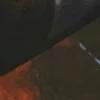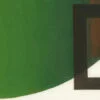In the Shadow of Things is the product of the months that Léonie spent with her mother as together they worked through the irrational rituals and behaviours that were dominating her life. It features Hampton’s original photographs alongside snapshots from family albums as well as transcripts of their conversations. She answers some questions for Granta’s Yuka Igarashi about her tender, mysterious and intimate portrait of a family.
YI: You were trained in documentary photography, and in your earlier work you’ve lived with and photographed families in France, Rome, Cuba and LA. Can you discuss what it’s like to have your family as a subject – and what it’s been like to have this work out in the world?
LH: In the case of In the Shadow of Things I saw the photography and work as secondary to the matter at hand: my family and I needed to try and face up to something that we were all hiding from. Being in someone else’s family was like trying to crack into an egg, whilst photographing my own family felt quite the opposite – more like trying to get out of the egg.
At the Museum of Everything, in north London, I read a caption by Grayson Perry about the artist Morton Bartlett’s work: ‘the transition of deeply held feelings into the glare of an audience can be a troubling one – a journey I identify with.’ Working with my mother, looking hard at her problems and trying to help her, while trying to make a photographic record of the process has been by far the most difficult thing I have ever done. However there would be little point in continuing to do this if it were purely troubling. The process of making the photographs has helped stagnant areas in my life and mind find ways to flow again. I also know that for my mother it’s important to her that the work may be a relief to other people burdened with their own secrets. Perhaps they might feel a slight relief to know there are other people like them in the world. At the same time this project has taught me to cherish the intense emotions created by confronting such a problem. These are what make us human, and in a sense these are my material.
It seems as if some of obsessive and ritualistic aspects of photography echoes OCD. Do you feel as if your art and your mother’s OCD are two sides of the same coin?
Yes I do. I think that is quite true. My mother was not always struggling in this way. I am the eldest child and remember quite clearly when she was in control. When the house was perfect. But there is that word: ‘perfect’. My father did not give much advice, hoping we would find our own way perhaps, but I do remember him once sitting me down telling me not to be a perfectionist. He thought it was the one characteristic to keep in check, because that perfect state does not exist, and that the failure of attaining it can destroy. My mother is an absolute perfectionist. Perfectionism and obsessiveness often go hand-in-hand. I think that many creative people are obsessive, and it’s often that element that takes the work to an interesting place. Some of the obsessions that channel into compulsive behaviour seem to me to be very destructive. Its like mismanaged and misguided obsession that needs an outlet. So yes, the photographs, the book – I see them as little ways of channeling my own deeply obsessive nature.
Along the same lines, your photography comes (at least partly) from the same impulse that drives your mother’s urge to hoard belongings, keep them packed. Are they both ways to preserve the past?
The holding onto the past, or the hoarding, is deeply echoed in photography as a medium. It is often characterized as collecting memories and freezing time. I am undecided as to whether I am doing this in my work. At points I certainly am. Sometimes I recognize that I am guilty of delaying my mother’s impulse to clear a room because I want to photograph it before it changes.
The format of the book seems integral to your vision: pages of uncaptioned photographs, intermixed with family snapshots and followed by transcripts from recorded conversations between you and members of your family. Did you know that you would be using all three when you started the project? How do you see the relationship between the photos, the snapshot and the transcript?
When I travelled in my early twenties I always used a sound recorder and a camera to plot my journey. So when I started photographing my own family I bought a new sound recorder to work with, initially to gather field recordings for sound installations. Soon I realized the conversations and domestic banter were interesting. In my first book dummy I tried to use quotes that would come on pages at certain points within the image sequence, but this did not work. The words broke the spell of the imaginary space I was trying to create with the image sequence, one that I had discovered by making a slideshow of the work for Foam Museum. Descriptive text tends to deflate tension. I decided that keeping the text and the images apart allowed different routes into my family’s world. I wanted to leave the book open for a layered experience of discovery. I like to allow a viewer to see the images with no information, and then return to them after reading the text. As for the archive, or snapshot sections, I hope they punctuate the book with a kind of emotional breathing space, by eluding to my mother’s past; times when things were different and her life was full of laughter and hope.
In the photos as well as the transcript, there is a delicate balance between revelation and mystery. Were you conscious about holding these two elements in tension?
I see a dichotomy at play where I am trying to be truthful, but it’s hard to be direct. So the language of the photographs is often indirect, secretive and clothed. I can recognize that I am hiding things. Things are not clear, not in focus. There are layers behind layers, reflections. I certainly do not want to be deliberately mystifying things. It’s more a sense of finding a visual language that reflect my own ‘unknowing’. I’d like to have been able to tell my story in a Nan Goldin or Richard Billingham-esque way – like a straight punch, raw and direct, but it’s not my character, nor would it have been right given the delicate balance that working with my mother demands.
The photographs often show the stark beauty of the landscape around the house. Do you think your work responds to ideas of British identity or British landscape?
My mother moved to the house in the middle of nowhere to ‘get away’ after the marriage to my father ended. Ironically, much of the woodland surrounding the house is owned by my father. For me this reveals something about English romanticism. We picture the countryside as being a pure thing of natural beauty, when actually it is laden with context and history. The English countryside is a human construct. Living in it does not automatically grant us escape.






